‘Let the beauty of what you find fresh guide you’: 8 summer vegetable recipes from the Arab kitchen
Simplicity can’t be beat, it’s true. And when vegetables are this fresh and tasty, you don’t need much to get the best out of them, writes Reem Kassis
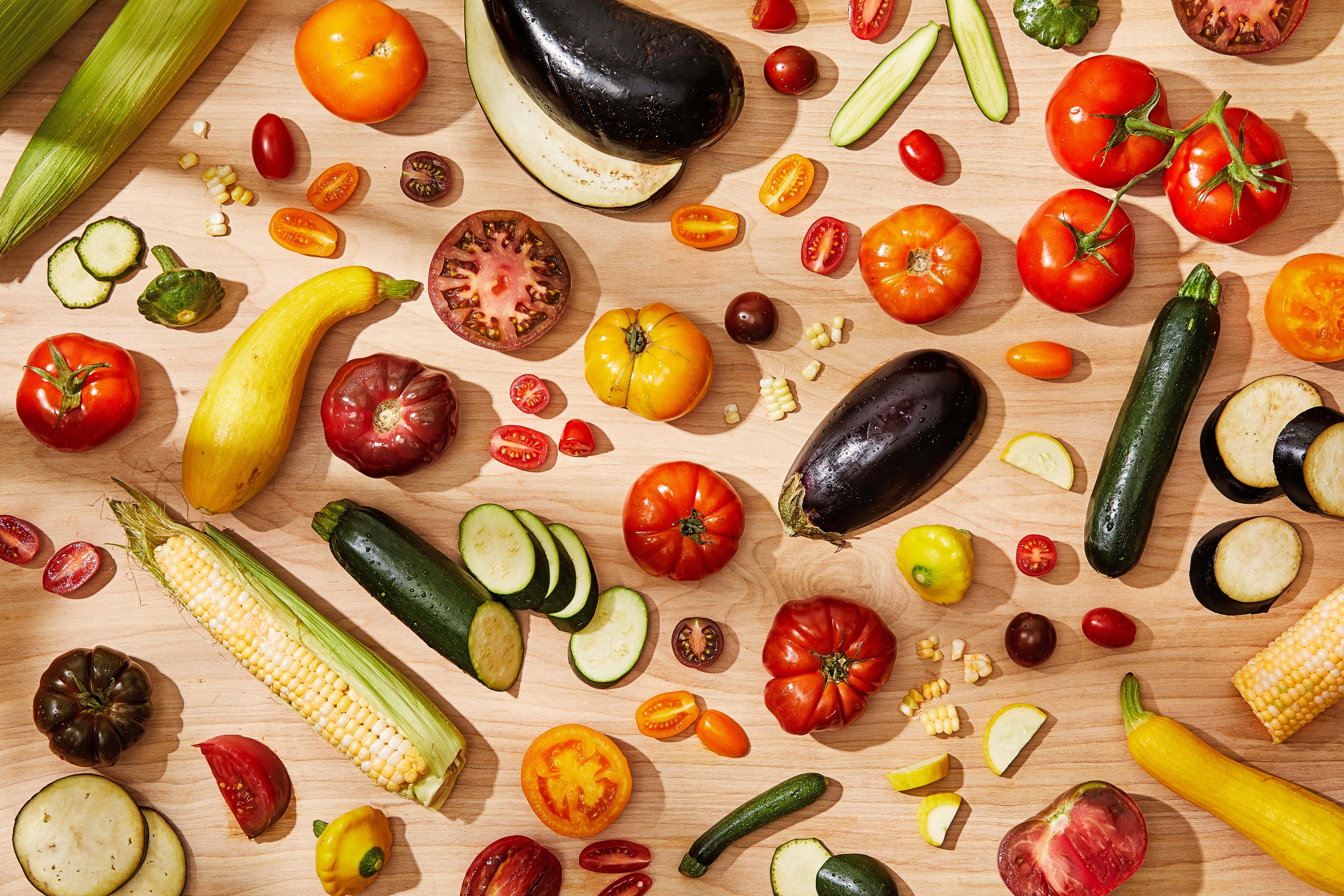
Your support helps us to tell the story
From reproductive rights to climate change to Big Tech, The Independent is on the ground when the story is developing. Whether it's investigating the financials of Elon Musk's pro-Trump PAC or producing our latest documentary, 'The A Word', which shines a light on the American women fighting for reproductive rights, we know how important it is to parse out the facts from the messaging.
At such a critical moment in US history, we need reporters on the ground. Your donation allows us to keep sending journalists to speak to both sides of the story.
The Independent is trusted by Americans across the entire political spectrum. And unlike many other quality news outlets, we choose not to lock Americans out of our reporting and analysis with paywalls. We believe quality journalism should be available to everyone, paid for by those who can afford it.
Your support makes all the difference.From a distance, it looks like paint palettes spread across tables as far as the eye can see, and as I inch closer, I see mounds of fresh produce in myriad shades and textures. Whatever rain shortage the summer season brings, the rainbows spread across farmers market tables more than make up for it. From deep-hued aubergines and blueberries to sunny apricots and red-flushed tomatoes, the colourful collection gives rise to a bubbling burst of happiness in my chest, not only for the beauty that surrounds me and my proximity to nature, but for the endless possibilities these fruits and vegetables afford.
Yet the excitement fades when I start thinking about what I can make with this gorgeous bounty. I search for advice from the farmers behind the tables. “They must know something I don't about coaxing the most out of produce,” I tell myself. The responses are surprisingly similar across the winding path through the market: raw or in salads, sautéed with olive oil with maybe onion or garlic and, at its most elaborate, a pasta sauce with all the ingredients and herbs thrown in.
Simplicity can't be beat, it's true. And when vegetables are this fresh and tasty, you don't need much to get the best out of them. But sometimes I crave something a little more exciting, flavours that are as bright as the colours in front of me. So in an effort to come up with easy and delicious recipes that are not your standard salad or sauté, I journeyed through the Arabkitchen, to some of the oldest cookbooks on record and to my own childhood in Jerusalem, where many of the Arab world's culinary traditions have converged.
I thought back to the days of waking up to the smells wafting from my mother's kitchen, such as garlic splashing into stews and pastries baked fresh in a taboon oven. I remembered my grandmothers' dining tables, where every dish appeared studded with jewels, from bursting pomegranate seeds to shiny fried nuts and bright green herbs. The dishes may have been simple, but it was the juxtaposition of unexpected ingredients and the combination of contrasting flavours and textures that kept you coming back for more.
The recipes I came up with draw inspiration from those dishes, and from the exciting and unusual history of the four vegetables highlighted, although three of them – tomato, aubergine and squash – are botanically fruits and the other, corn, is technically a grass. So approach these recipes as a map for what to do with the season's bounty, then let the beauty of what you find fresh guide you.
Tomatoes
What are some of the first dishes that come to mind when you think of Italian cuisine? Is it pasta al pomodoro? Or lasagna Bolognese? Pizza margherita, perhaps? Maybe even panzanella or caprese salad? If you include Italian-American classics, aubergine Parmigiana or spaghetti and meatballs might come to mind. Tomatoes are so intertwined with Italian cuisine that even the canned ones are more highly prized if they hail from Italy or are an Italian variety, such as San Marzano.
Yet tomatoes did not arrive in Italy until the 16th century, and it wasn't until the 18th and 19th centuries that staple tomato dishes began to emerge. If you ever imagined Julius Caesar, Marco Polo or Michelangelo swirling silken strands of pasta in a luscious red sauce, rest assured they did not.
It wasn't until the Spanish conquest of the Aztec empire that tomatoes traversed the Atlantic Ocean and arrived in Europe. Even so, they were still regarded with skepticism and fear because botanists recognised them as relatives of the poisonous nightshade, belladonna. Their beauty trumped this fear only enough to have them cultivated as ornamentals. Unique varieties developed over time, however, eventually allowed the tomato to reign supreme in many Mediterranean cuisines.
Having made their way to the Middle East sometime between the 16th and 19th centuries, tomatoes are now a staple in the Arabic kitchen, as well. The Arabic word banadura, similar to the Italian word pomodoro, hints at one possible route - from Italy to Egypt. Their arrival brought a fundamental change to Arab cooking: Stews, the staple Arab dish, started to use tomato as a key ingredient for thickening, souring and colour in place of nuts, juices and saffron, respectively. The Middle Eastern cuisine we know today, where tomatoes play a dominant role, looks very different from that of a few centuries ago.
Although tomatoes are popular in stews and salads across the Arab world, the recipes here bring you loads of flavour while keeping the very beauty that made people grow tomatoes as flowers still noticeable.
Garlic, mint and chilli-fried tomatoes
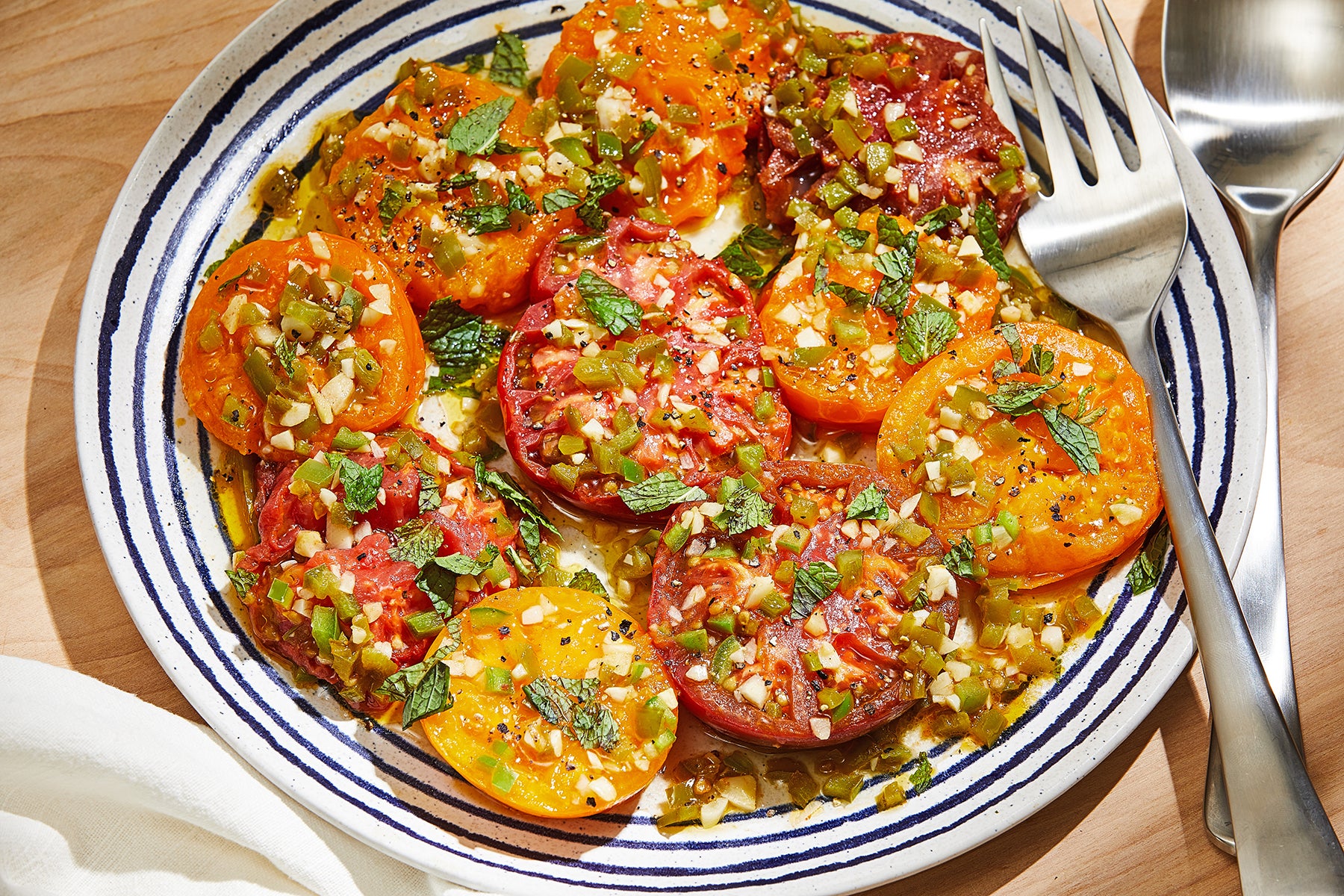
Time: 30 minutes
Makes: 4 servings (as an appetiser)
Summer is the time to make this dish, because the quality of tomatoes used for it makes a huge difference. Summer and heirloom varieties that are fleshy and not filled with watery seeds are ideal for this take on the Levantine dish called "alayet bandora," in which tomatoes are fried until they break down into a thick, chunky sauce.
In this version, the tomatoes retain their shape for an impressive look that also allows you to taste each element fully. Try to use the same variety of tomato and ones that are about the same ripeness and size for more even cooking.
Recipe notes: Leftovers can be refrigerated in a covered container for up to 2 days (gently reheat before serving), or frozen for up to 2 months. Alternatively, lightly mash the tomatoes with a fork or blitz in a blender, and use as a tomato sauce base for another recipe.
Though Kassis loves the garlic-mint combination, you could substitute cilantro or basil.
Ingredients:
4 to 6 large firm heirloom tomatoes (about 2 1/4 pounds total), halved through the equator
4 tablespoons extra-virgin olive oil
10 large cloves garlic, finely chopped (not crushed)
2 to 3 fresh green chilis, such as jalapeño chili peppers or anaheim, seeded, ribbed and finely chopped
1/2 teaspoon fine sea salt
2 tablespoons finely chopped fresh mint leaves (or 2 teaspoons dried)
Freshly cracked black pepper (optional)
Pita bread or good crusty bread, for serving
Method:
Arrange the tomato halves, cut-side down, in a skillet large enough to fit the pieces snugly. Pour the olive oil over the tomatoes and set the pan over medium heat until oil has heated up and tomatoes have cooked slightly on the cut-side, about 5 minutes.
Flip the tomatoes over and scatter half the garlic and chiles on top of the tomatoes, allowing some to fall into the oil in the gaps between the halves. Scatter the rest in the gaps between the tomato halves. The garlic and chiles in the oil will crisp as the dish cooks. Season with the salt, cover the pan, reduce the heat to low, and cook until the tomatoes have started to soften but still retain their shape, 10 to 15 minutes.
Check on the tomatoes several times while cooking and, tilting the pan, spoon some of the oil mixture over the tomatoes. Cooking time will vary with size and ripeness of the tomatoes. When almost done, sprinkle the mint over the tomatoes, cover the pan, and cook for about 1 minute. Finish with light sprinkling of black pepper, if using.
Remove from the heat and serve with bread to mop up the juices.
Halloumi, za’atar and tomato tart
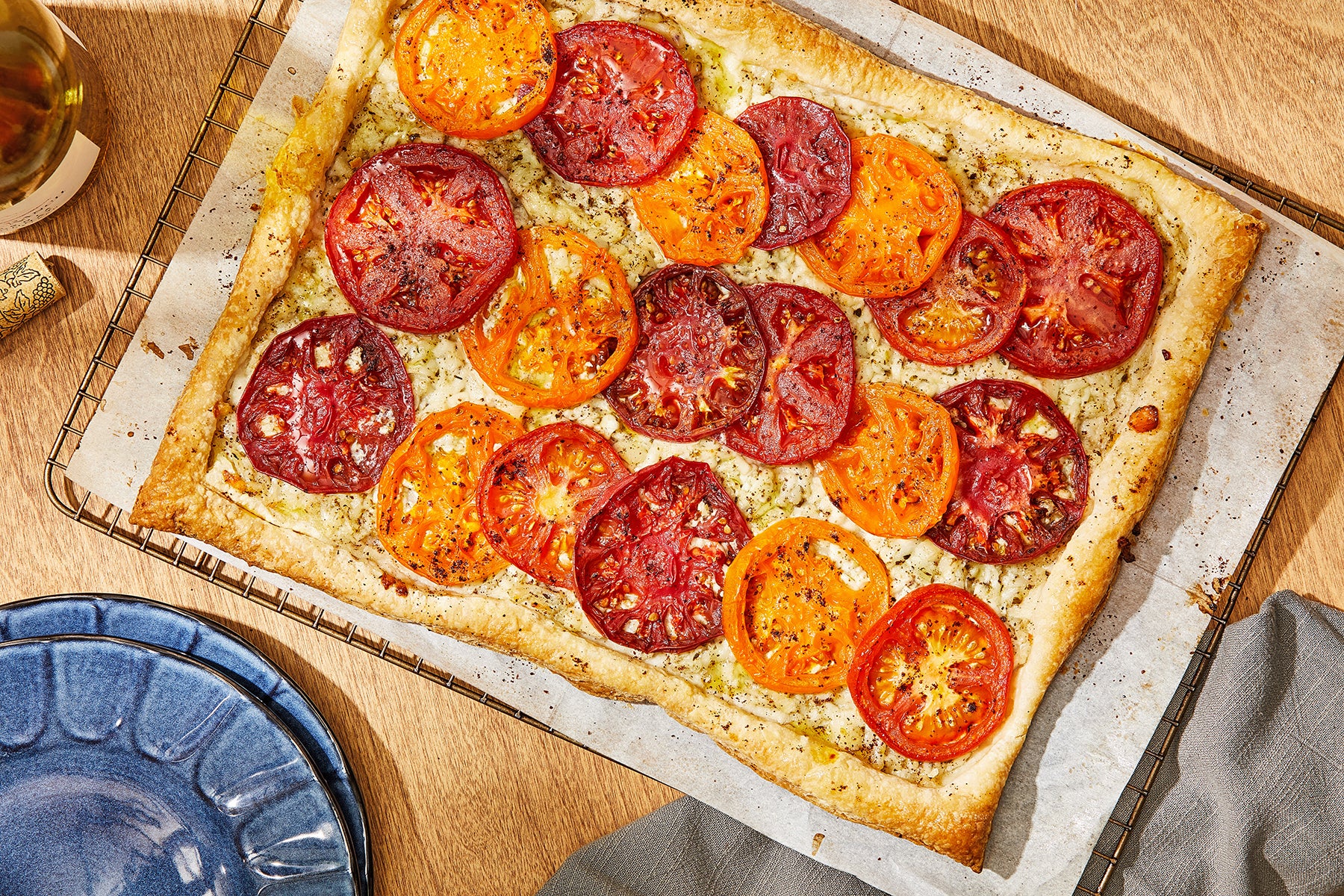
Active time: 20 minutes | Total time: 40 minutes
Makes: 6 to 8 servings
Manaqeesh are traditional Levantine flatbreads, usually topped with za'atar or cheese and then baked. Fresh tomatoes, and sometimes cucumbers, are almost always served alongside these breads, which work just as well for breakfast as they do for lunch or a light supper.
This recipe is a riff on the classic cheese version, but with puff pastry used as a shortcut and tomatoes layered on top for a visually stunning dish. Don't skip salting the tomatoes; it's important if you wish to avoid a soggy tart.
Recipe note: Leftovers can be refrigerated for up to 2 days. Reheat in a 350-degree oven for about 10 minutes.
Ingredients:
3 medium heirloom tomatoes (about 1 1/2 pounds total) in different colors
Fine sea salt
250g halloumi cheese, shredded or coarsely grated
2 tablespoons labneh or Greek yogurt
2 teaspoons za'atar blend (can substitute with dried mint or oregano)
One (450g) package puff pastry, defrosted overnight in the refrigerator or according to the package instructions
Unbleached all-purpose flour, for dusting
Extra-virgin olive oil, for drizzling
2 to 3 teaspoons ground sumac, for sprinkling
Method:
Position a rack in the middle of the oven and preheat to 200C.
Line a large, rimmed baking sheet with paper towels or a clean dish towel. Slice the tomatoes crosswise into circles about 1/4-inch thick and place them on the towel-lined baking sheet. Sprinkle with salt on both sides to draw out moisture and cover with more towels to absorb the released juices while you prepare the crust.
In a medium bowl, stir together the cheese, labneh and za'atar until combined.
Cut a piece of parchment paper so that it will fit inside another large, rimmed baking sheet. Place the parchment on the counter and dust it with flour. Place the puff pastry on top of the parchment paper, sprinkle with more flour, and roll it out to a 12-by-14-inch rectangle. (Do not go beyond 12 inches on the short side or it will not fit on the sheet pan.) Transfer the parchment paper with the pastry to the second baking sheet.
With the tip of a sharp paring knife, score an approximately 1-inch border around the pastry, being careful not to cut through it.
Spoon the cheese mixture over the pastry, taking it up to, but not over, the scored border. Layer the tomatoes on top, letting them overlap slightly. Drizzle with the olive oil and sprinkle generously with sumac, to taste.
Bake for 20 to 25 minutes, or until the border puffs up and is nicely browned. Transfer to a wire rack and let cool for a few minutes or completely before slicing and serving.
Aubergines
A vegetable described by medieval Arabs as "the colour of a scorpion's abdomen with a taste like its sting," according to "The Culinary Crescent" by Peter Heine, is certainly not one I would rush to consume, especially if it's also thought to induce madness, depression and blood inflammation. But that is – or was – the aubergine in the medieval Arab world. It might be hard to fathom that this vegetable (technically a fruit), which today boasts a recipe list more numerous than the seeds in its belly, was so described at one point in history.
Originating somewhere in South and East Asia, the aubergine was cultivated for thousands of years before its journey westward into the Arab world. But rather than embracing the aubergine upon arrival, the Arabs shunned it, fearing its looks, which resembled varieties of poisonous nightshade, and loathing its spongy texture and bitter taste. Though appreciated in Southeast Asia, as the aubergine moved farther west, that bitterness hindered its popularity.
Then, at a lavish December feast in AD825, at which a beautiful woman nicknamed Buran was married off to Caliph al-Ma'mun, the aubergine's fate began to change. On the occasion of the wedding, one of the most magnificent feasts Baghdad ever witnessed, the palace served an aubergine dish purportedly invented by Buran herself. Although today we know it simply consisted of aubergines that had been salted and rinsed before being fried, the dish was extraordinary for its time. It is likely from there on that people understood how to rid aubergine of bitterness, leading to a surge in its popularity. It's also why many aubergine dishes are referred to as Burraniyat today. Suddenly, the scorpion faded into oblivion and aubergine became, as described by Arab poet Abu al-Fath (Khushajim), "a pearl in a black gown with an emerald set."
In Europe, acceptance was slower. It is only in 13th-century Spain that interest in the aubergine began to rise. In Italy, it wasn't until the 15th century that aubergine was commonly eaten as a Lenten food. In France, even by the 18th century, it was known only in the south. If much of this hesitance was caused by myths, at least a portion was attributable to a lack of good recipes.
The recipes here capitalise on aubergine's meaty texture and sweet smokiness as a great conduit for other ingredients and flavours. Today, aubergines are bred to not have much of the bitterness they held historically, so salting is no longer required. Although some people will argue that it affects the texture and oil absorption, I find the difference so marginal that it doesn't merit the time and effort.
Aubergine bread salad
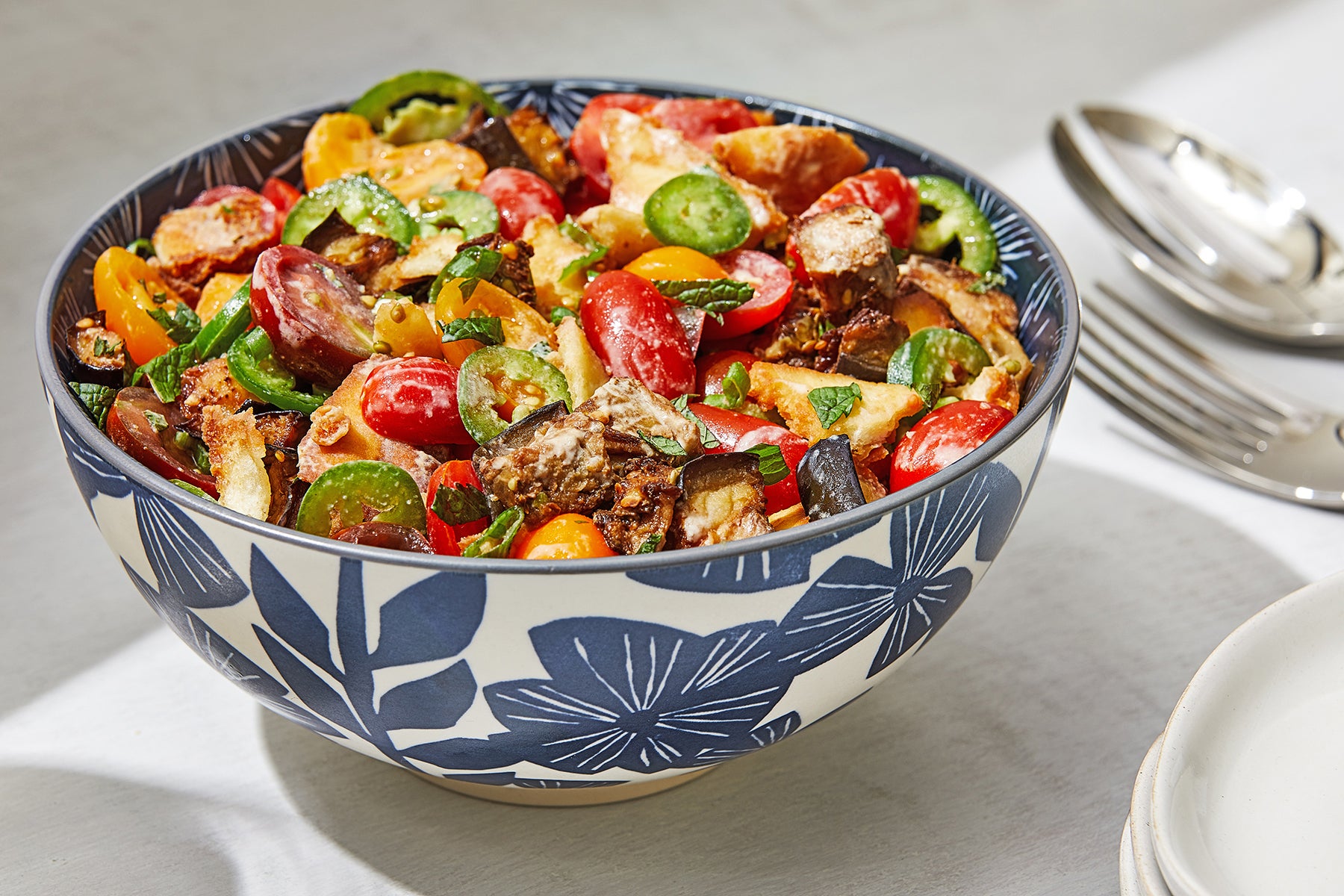
Active time: 20 minutes | Total time: 40 minutes
Makes: 4 servings
Throwing stale bread into salad is a practice born out of necessity and is common across many cultures. The results can be so delicious, it has become normal to toast bread specifically for salads.
This one takes the traditional Palestinian tomato-tahini salad and marries it with fried aubergine sandwiches, reimagining both as a single dish.
For easier preparation, you could broil the aubergine instead of frying it, but there is something decadent about the fried version that makes it worth the effort.
Recipe note: The croutons can be stored at room temperature in an airtight container for up to 3 days.
Ingredients:
Bite-size pieces pita bread
1 teaspoon extra-virgin olive oil
280g tomatoes, cut into bite-size pieces (or halved, if using cherry tomatoes)
1/2 teaspoon fine sea salt or table salt, plus more as needed
Vegetable oil, for deep-frying
1 medium aubergine (about 340g), trimmed and diced into 1-inch cubes
3 tablespoons fresh lemon juice
2 tablespoons tahini
2 scallions, thinly sliced
1 green chili, such as jalapeño chili pepper or anaheim, thinly sliced
Leaves from 3 sprigs fresh mint, finely chopped
Method:
Make the salad: Position a rack in the middle of the oven and preheat to 180C.
Arrange the bread on a large, rimmed baking sheet, drizzle with the olive oil and toss to combine. Bake for 15 to 20 minutes, until crisp but not browned. Remove from the oven and set aside.
While the pita chips are baking, place the tomatoes in a large colander set over a bowl and sprinkle with the salt. Set aside for at least 20 minutes, tossing occasionally, to let the juices drain into the bowl.
Meanwhile, in a large, heavy pan or Dutch oven over medium high heat, add enough oil to come 3 inches up the sides and heat until it registers 180C on an instant-read thermometer or until a morsel of bread immediately rises to the surface and bubbles vigorously when dropped in. Line a large plate with paper towels or clean kitchen towels and keep near the stove.
Working in batches if necessary, fry the aubergine pieces until uniformly golden brown, 5 to 8 minutes. Use a slotted spoon to transfer the aubergines to the towel-lined plate and sprinkle with salt.
Measure 2 tablespoons of drained tomato juice into a small bowl. Add the lemon juice, tahini and a pinch of salt and stir to combine.
Transfer the tomatoes to a serving bowl and add the fried aubergine, scallions, chili, mint and pita chips. Drizzle with the tahini sauce and toss to combine. Let the salad sit for 5 to 10 minutes to let the bread absorb the dressing, then serve.
(Due to the varying amounts of oil used in frying, ingredients are too variable for a meaningful analysis.)
Aubergine steaks with herbed yoghurt, nuts and pomegranate
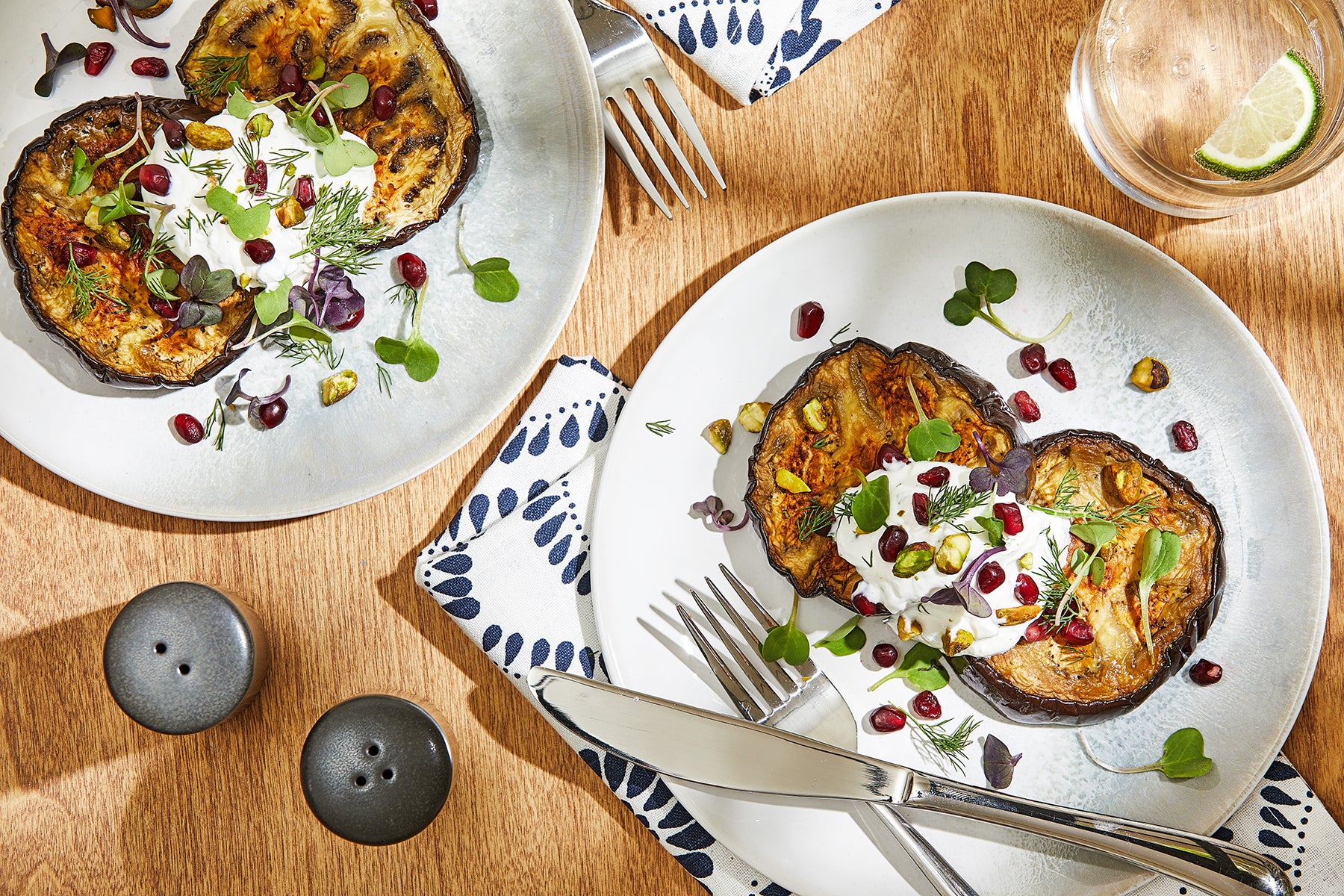
Active time: 15 minutes | Total time: 30 minutes
Makes: 4 to 6 servings
This is a dish that tastes as good as it looks. The herbs, pomegranate seeds and nuts look like jewels adorning the yogurt-clad aubergine slices. The best thing about the dish is its versatility: Use whatever herbs look freshest to you, and mix and match the nuts as you like. Keep the aubergine steaks on the thicker side so they hold their shape.
Storage Notes: Leftovers can be refrigerated in separate containers for up to 1 day.
Ingredients:
For the aubergines:
3 medium-to-large aubergines, sliced into 1-inch thick rounds
Extra-virgin olive oil, for brushing
Fine sea salt or table salt
Freshly ground black pepper
For the yoghurt sauce:
450g plain whole-milk Greek yogurt
2 tablespoons finely chopped fresh green herbs such as dill, mint, cilantro, parsley or a combination
1 small clove garlic, crushed or finely grated
1/2 teaspoon fine sea salt or table salt
1/2 teaspoon fresh lemon juice
For the garnish:
2 tablespoons pomegranate seeds
8 tablespoons lightly toasted mixed nuts such as almonds, pistachios, hazelnuts or pine nuts
1 small handful of fresh green tender herbs or leaves such as dill, radish greens, cilantro, chives or baby arugula
Method:
Roast the aubergines: Position a rack about 6 inches away from the broiling element and heat the broiler. Place the aubergine slices on a wire rack set over a baking sheet or directly on a sheet pan lined with foil. Brush both sides of the aubergines with the olive oil and season with salt and pepper. Place the aubergines in the oven and broil for about 10 minutes, or until they develop a golden-brown exterior. Turn aubergines over and repeat until the other side is also a golden brown, another 10 minutes.
Make the yogurt sauce: While the aubergines are roasting, in a medium bowl, whisk together the yogurt, herbs, garlic, salt and lemon juice until smooth.
Once the aubergines are done, arrange them on a platter or place two aubergine steaks on individual plates. Spoon generous dollops of the yogurt sauce over the aubergine, then top with pomegranate seeds, nuts and greens and serve.
Summer squash
If the name confuses you, it's for good reason. Summer squash are probably some of the most misunderstood types of produce, and even the Oxford Companion to Food acknowledges, "there is no fully effective way to sort out the confusion." Summer squash belong to the genus cucurbita, which is part of a large family that includes watermelon, cucumber and chayote. Even within the genus, there are several varieties - summer squash, winter squash, gourd and pumpkin - with a lot of overlap. The entire genus is of American origin, and the group that includes summer squash is the largest and oldest: Archaeologists have discovered remains of its rind and seeds in Mexico dating to at least 7000 BC.
Given this long history, you might be surprised to learn that the summer squash we know today, of which courgette is the most recognised member, only became prominent in European, Mediterranean and Arab cuisines in the 19th and 20th centuries. Squash made their way from the Americas to Europe during the Columbian exchange in the 16th century, but the varieties that arrived were almost certainly different from what we recognise today. For starters, they would have been comparatively enormous. In fact, zucchini was marketed in, and later developed to be, its smaller size in Italy only in the 19th century.
If the history and nomenclature weren't confusing enough, the botany adds another layer. Zucchini and their summer cousins – such as cousa, zephyr, yellow squash and crookneck – are all technically fruit, and the part we eat is nothing more than the swollen ovary of the flower, the female of the plant. The male flowers are attached to a long stem instead of being attached to a fruit.
Science and history aside, summer squash is delicious. It's mildly sweet, with a pleasant texture that pairs well with many flavours. In the Arab world, cousa is most commonly available, but what we lack in variety we more than make up for in application. While summer squash in the United States tend to be sautéed, grilled or fried, and possibly added into sauces and pasta, in the Middle East the uses range from pureed for dips and spreads to stuffed, braised, stewed and even used in fattehs, a class of dishes where toasted bread is topped with various proteins, vegetables and sauces. The recipes here feature a traditional rustic dish eaten across the Levant, as well as a more modern application, which allows the summer squash's texture and flavour to shine alongside Arab flavors.
Bulgur pilaf with caramelised onion and cousa
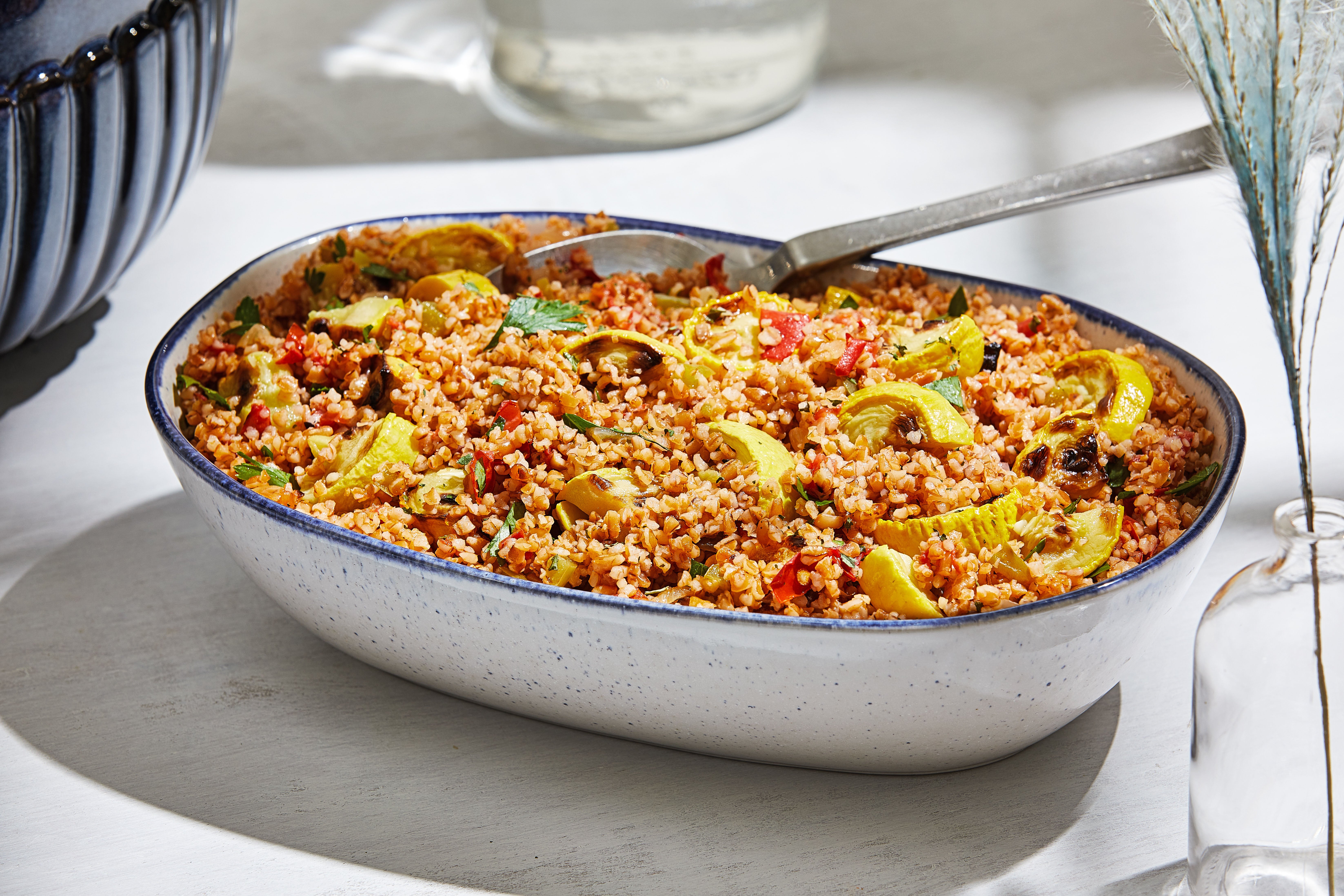
Active time: 25 minutes | Total time: 40 minutes
Makes: 4 to 6 servings
This is a peasant dish from the Levant called by different names depending on locales, but variations of it are common across the eastern Mediterranean.
Cousa, a summer squash that's firmer and sweeter than a standard zucchini, is the most common variety across the Middle East. To retain its lovely flavour and texture, the squash is cooked separately and folded in at the last minute.
For a prettier presentation, instead of mixing in the cousa, simply pile it on top of the bulgur in the serving platter and drizzle with more olive oil. The great thing about this recipe is that it tastes just as delicious warm as it does at room temperature, so it is the ideal make-ahead or picnic dish.
Recipe note: Leftovers can be refrigerated for up to 4 days; reheat gently on the stove with a few splashes of water, or bring to room temperature and eat.
Ingredients:
For the bulgur:
5 tablespoons extra-virgin olive oil, divided
340g coarse grain bulgur, rinsed and drained
1 yellow onion (any size), finely diced
1 small green bell pepper or (may be substituted with 3 jalapeños if you prefer it spicy), finely diced
2 large or 3 medium tomatoes, finely diced
1 tablespoon tomato paste
600ml water, plus more as needed
2 teaspoons fine sea salt or table salt
1/2 teaspoon freshly ground black pepper
3 tablespoons fresh lemon juice
3 tablespoons finely chopped fresh parsley leaves
2 teaspoons crushed dried mint
For the cousa:
450g cousa squash (often called Mexican grey or Korean squash), or any other variety of summer squash except green courgette, diced into bite-size pieces
1 tablespoon extra-virgin olive oil
1 teaspoon fine sea salt
Plain whole-milk yogurt (optional)
Lemon wedges (optional)
Method:
Make the bulgur: In a large pot over medium heat, heat 3 tablespoons of the oil until hot but not smoking. Add the drained bulgur and cook, stirring regularly, until slightly toasty and fragrant, 3 to 5 minutes. Transfer to a bowl.
To the same pot, add the remaining 2 tablespoons of the oil, the onion and pepper and cook, stirring regularly, until the onions soften and start to brown, 9 to 11 minutes. Add the tomatoes and tomato paste and continue to cook, stirring occasionally, until the tomatoes start to break down and release their juices, and the mixture slightly darkens, an additional 5 to 7 minutes.
Add the water, salt and pepper, and bring to a boil. Return the bulgur to the pot and stir to combine. Lower the heat so the mixture is at a simmer, cover, and cook until the bulgur is fluffed up and tender, 15 to 20 minutes (the timing may vary depending on brand of bulgur you use). Stir periodically to make sure the mixture doesn't stick to the bottom. If necessary, add more water, a few tablespoons at a time, and continue to cook until the grains are soft but not mushy.
Make the cousa: While the bulgur cooks, position a rack about 6 inches away from the broiling element and heat the broiler.
In a large bowl, toss the cousa with the olive oil and salt, and spread it in a single layer on a large, rimmed baking sheet. Broil for 10 to 12 minutes, watching carefully, until the cousa is charred in spots and starting to soften.
Remove the bulgur from the heat, add the lemon juice, parsley, dried mint and roasted cousa and toss to combine. Transfer to a serving platter or bowl.
Serve warm or at room temperature, with the yogurt and lemon wedges on the side, if using.
Feta yoghurt with charred squash, hazelnuts and corianders
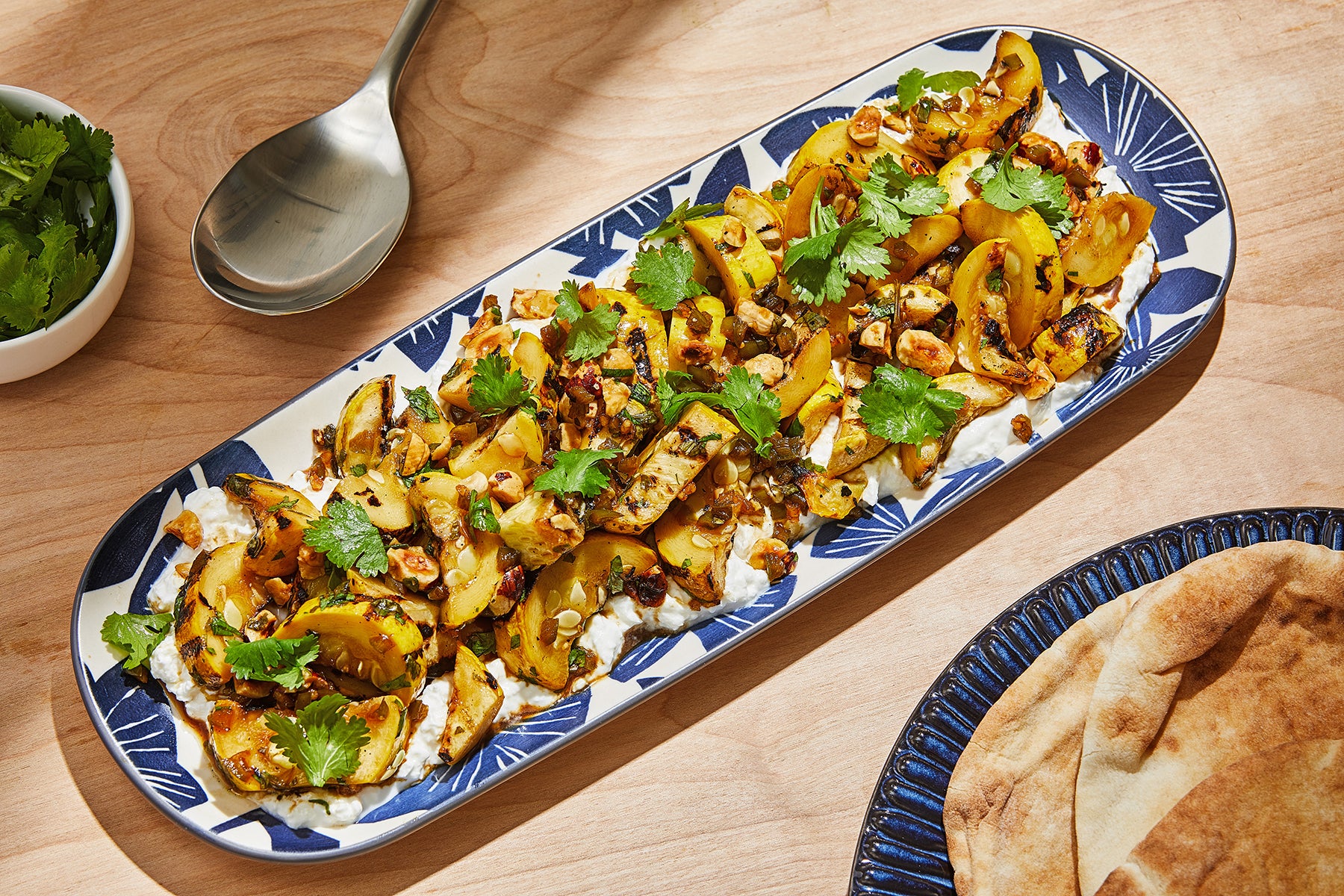
Active time: 20 minutes | Total time: 35 minutes
Makes: 4 servings
Labneh across the Middle East tends to be tangy and salty with a distinct umami flavour, probably because it was made with sheep's milk whereas elsewhere it's usually made with cow's milk. In the United States, mixing feta with yogurt gives the closest approximation of that flavour. This mixture becomes the perfect base for roasted squash with aromatics and hazelnuts. The savoury, creamy base allows the sweet crispness of the squash to shine, and the presentation makes it a dish that would be fit for a quick lunch or a dinner party.
Storage Notes: Leftovers can be refrigerated in a covered container for up to 1 day. You can also mix the leftovers together with a fork until you have a mutabal (baba ghanouj) like consistency, which can be refrigerated for up to 2 days, though the nuts will lose some of their crunch.
Where to Buy: Pomegranate molasses can be found at Middle Eastern markets or well-stocked supermarkets.
Ingredients:
For the yoghurt base:
140g plain or Greek yogurt
100g feta cheese, preferably sheep's milk
For the squash:
450g cousa squash (often called Mexican gray or Korean squash) or any other variety of summer squash except green zucchini
2 tablespoons extra-virgin olive oil, divided
30g hazelnuts, toasted and coarsely chopped (may substitute with almonds)
2 tablespoons finely chopped fresh cilantro, plus a few leaves for garnish
1 tablespoon pomegranate molasses
1 tablespoon fresh lemon juice
1 green chili such as jalapeño pepper, seeded and finely diced
1 small clove garlic, crushed
1/2 teaspoon fine sea salt or table salt
Method:
Make the yogurt base: In a medium bowl, stir together the yogurt and feta, mashing the feta as you go along, until it is evenly incorporated. Spread the mixture in a shallow serving platter.
Make the squash: Heat a grill pan over medium heat. Halve each squash lengthwise, place them in a bowl and toss with 1 tablespoon of the olive oil. Place the slices, cut side down, on the grill pan and cook undisturbed until dark grill marks appear, 4 to 5 minutes. Flip and cook until the skin side is also charred but the squash still retains some crunch, about 5 minutes. Return the squash to the bowl and let cool slightly.
When the squash is cool enough to handle, slice it into 1/2-inch segments. Return the squash to the bowl, add the hazelnuts, cilantro, the remaining olive oil, pomegranate molasses, lemon juice, chili, garlic and salt and toss gently to combine.
To serve, spoon the squash mixture into the centre of the yogurt base and sprinkle with more cilantro leaves.
Corn
Corn, technically a grass, is one of the most important staple foods in the world. Yet you would be hard-pressed to find this crop, which can trace its roots back to Central and South America, on a regular basis in any Arab home. But distance is not the culprit. Most produce that made its way to Europe from the Americas following the Columbian exchange also took root in the Middle East via trade, travel and colonisation. Potatoes, tomatoes, peanuts, squash and chiles have all burrowed their way into Arab cuisine and feature heavily in our meals and snacks. Corn, somehow, is the exception. The reason, though, remains as elusive as those silken strands we struggle to remove from the cobs.
When and how corn made its way to Africa and Asia, where historical accounts are scarce or contradictory, is still not established. But its introduction into the Arab world likely happened at some point between the 17th and 19th centuries. The only way I ate corn growing up was on the cob, and it was a rare occurrence. The varieties available in Jerusalem were nowhere near as sweet as the ones I have come to know and love here in the United States.
If flavour alone wasn't the reason for its less-than-stellar popularity, stigma might have been. Historically in the Levant, field corn was grown then dried and made into a coarse flour that was used to make breads called karadeesh. The use of this flour, however, was usually associated with poverty. So as people gained access to more options, these breads, along with corn flour, sunk into oblivion. Today, corn is still not a staple ingredient in any Arab cuisine, making an appearance only in salads every so often.
When cooking, I often find it is contrasts that make a dish sing. So fret not, for the sweetness of corn makes it a wonderful foil for many of the sharp and tangy flavours we love in Arab cuisine. So while the recipes here give you two suggestions for how to marry this quintessential American summer ingredient with Middle Eastern flavours, consider them a blueprint for how to blend sweet with sour and creamy with crunchy to create dishes that might seem simple, yet whose flavours are anything but.
Caramelised corn and sumac over labneh
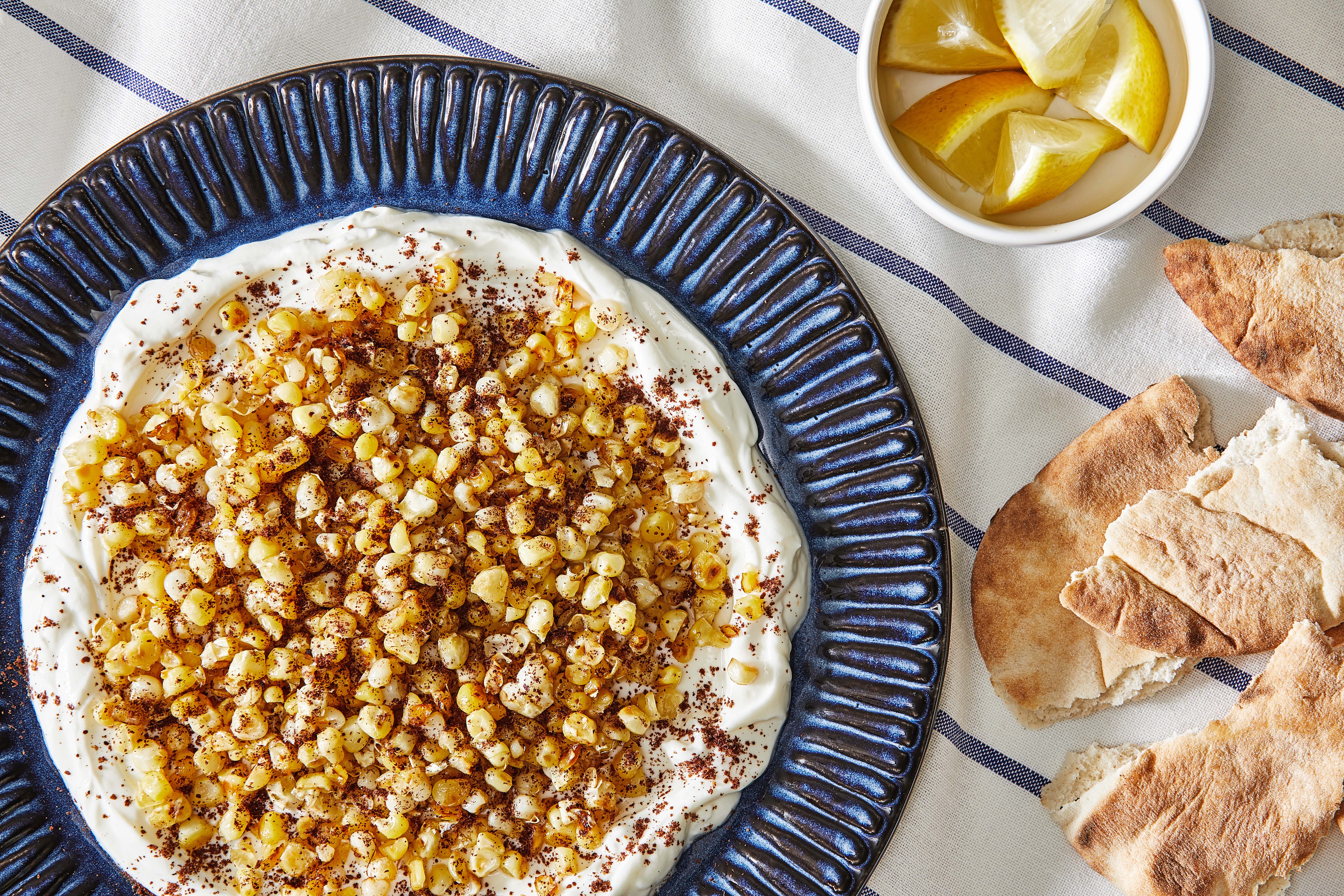
Total time: 15 minutes
Makes: 4 servings (makes about 2 cups)
Labneh (or labaneh in the Palestinian dialect) is a staple on most Levantine tables. It's what mothers spread on bread, often with za'atar, for school lunches, and it's what cookbook author Reem Kassis's father, like many others, has scooped up with bread for breakfast for the past 70 years. This recipe takes corn, an unusual ingredient for the Arab world, and pairs its sweet crunch with the tangy creaminess of labneh for a treat that is just as good scooped up with bread as it is spread on a cracker or eaten alongside grilled meats.
NOTE: Labneh varies drastically from brand to brand, but traditional varieties eaten across the Arab world are usually made out of sheep or goat milk and tend to be quite tangy and salty. In the United States, most labneh is not as salty or tangy, hence the added salt and lemon juice in this recipe. If you like the way your labneh tastes, feel free to omit the salt and lemon. You can also make your own labneh by straining plain yogurt in a cheesecloth overnight and then adding salt.
Storage Notes: Leftovers can be refrigerated in a covered container for up to 2 days. To keep longer, for up to 5 days, store the labneh and corn separately, and assemble the portion you need right before serving.
Ingredients:
1 ear of corn, shucked
1 tablespoon extra-virgin olive oil, plus more for drizzling
230g labneh (see NOTE)
1 teaspoon fresh lemon juice
1/2 teaspoon fine sea salt or table salt
2 teaspoons ground sumac
Pita bread, for serving
Lemon wedges, for serving (optional)
Method:
Place the corn cob horizontally on a large cutting board and, using a very sharp chef's knife, cut the kernels off as close to the cob as possible. You should get about 140g of kernels.
In a large, nonstick skillet over medium heat, heat the oil until shimmering. Add the corn in a single layer and cook without stirring until the kernels sizzle and pop and start to caramelise, 3 to 4 minutes. Toss the kernels well – they will have browned in spots – and spread out in a single layer again. Cook until the kernels are browned all over, about 3 minutes more. Remove from the heat and allow to cool slightly.
While the corn is cooking, in a medium bowl, whisk together the labneh, lemon juice and salt until combined.
To serve, spoon the labneh into a shallow serving bowl and use the back of a spoon to make a well in the centre. Place the corn in the well, drizzle with olive oil and sprinkle with the sumac.
Serve with pita, with lemon wedges on the side for squeezing.
Corn salad with halloumi, peppers, olives and cumin-lemon dressing
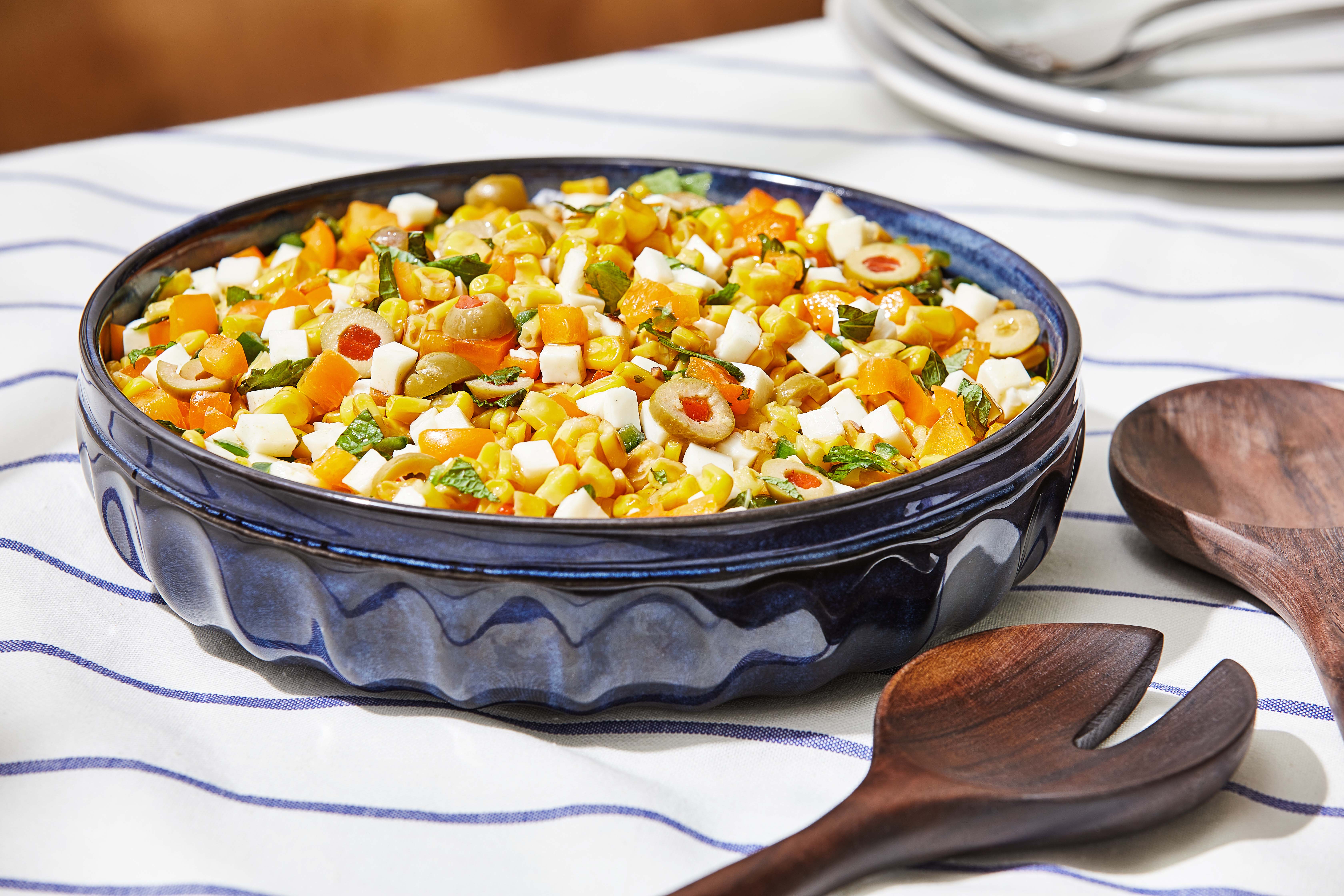
Time: 25 minutes
Makes: 4 servings
The contrast of textures and tastes in this salad is what makes it sublime, and pan-frying the corn kernels instead of boiling them adds another layer of flavour to an otherwise simple dish. You could substitute feta, preferably Bulgarian, for the halloumi (see VARIATION).
Leftover salad can be refrigerated in an airtight container for up to 2 days.
Variation: If you can't find halloumi and want to substitute feta, crumble it on top at the very end, and mix right before serving. Once you toss the ingredients together, the feta will mix with the dressing and form a creamy emulsion that coats the salad. It makes for a more beautiful presentation to leave the feta on top until the last minute.
Ingredients:
For the dressing:
2 tablespoons extra-virgin olive oil
2 tablespoons fresh lemon juice
1/2 teaspoon fine sea salt or table salt
1/4 teaspoon ground cumin
For the salad:
3 ears of corn, husked
2 tablespoons extra-virgin olive oil
1 red or orange bell pepper, diced to size of corn kernels
1 jalapeño peppers, finely diced
140g halloumi cheese, diced to size of corn kernels; you may substitute feta (see VARIATION)
8 to 10 pitted green olives, such manzanilla or pimento-stuffed, thinly sliced
4 tablespoons cup coarsely chopped fresh mint leaves
Method:
Make the dressing: In a large salad bowl, whisk together the olive oil, lemon juice, salt and cumin until combined.
Make the salad: Working with one ear of corn at a time, place a cob horizontally on a large cutting board and, using a sharp chef's knife, cut the kernels off as close to the cob as possible.
In a large, nonstick skillet over medium heat, heat the oil until shimmering. Add the corn in a single layer and cook without stirring until the kernels sizzle and pop and start to caramelise, 3 to 4 minutes. Toss the kernels well – they will have browned in spots - and spread out in a single layer again. Cook until the kernels are browned all over, about 3 minutes more. Remove from the heat and allow to cool slightly. (If your skillet is smaller, you may need to cook the corn in batches.)
Once the corn has cooled, add it to the bowl, followed by the bell pepper, jalapeño, halloumi, olives and mint, and toss to combine.
Serve warm, at room temperature or chilled. If serving from the refrigerator, let sit at room temperature for about 10 minutes to take the chill off.
© The Washington Post



Join our commenting forum
Join thought-provoking conversations, follow other Independent readers and see their replies
Comments